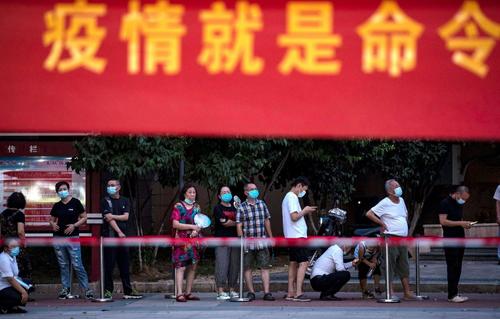China Suspends Travel, Ramps Up Testing As Delta Outbreak Hits Wuhan
China’s worst outbreak since COVID first emerged in the city of Wuhan has continued to spread, prompting authorities to intensify their efforts to crush the delta-driven outbreak. However, as the virus continues to elude their grasp, it’s looking increasingly likely that Beijing’s “zero tolerance” approach might hamstring economic growth, as analysts from Goldman Sachs warned in a recent note to clients.
More than 2 dozen cities have counted more than 300 cases over the past few weeks as the number of cases has quickly multiplied. China now has 144 medium- and high-risk areas – the most since the initial outbreak in early 2020, according to the National Health Commission.
By Monday, all of China’s 31 provincial-level jurisdictions had issued notices by Monday advising people not to travel domestically. Some provincial governments singled out only medium- and high-risk regions, while others asked people to avoid all inter-provincial travel. According to the SCMP, Beijing’s “zero-tolerance” approach to fighting COVID, which remains minimal compared with China’s vast population, has “scared away” the tourists.
China reported 71 new COVID cases from local transmission on Wednesday, more than half of them in coastal Jiangsu province near the epicenter of Nanjiang, AP reported.
The CCP has decided to expand travel restrictions on Wednesday: ride-hailing services and public transit have been suspended in all medium- to high-risk areas. Immigration authorities have promised to “strictly restrict non-urgent, unnecessary cross-boarder travel” including restricting the issuing of passports for Chinese citizens. To try and stifle the virus before it has an opportunity to take hold, the city ordered millions of residents to undergo mandatory testing, leading to lines forming across the city. The city has also closed 17 bus lines and a handful of subway stations. Cases have been confirmed in 17 provinces and some two dozen cities, including Wuhan, which reported a handful of cases this week, per CNN.
Fears of another crushing lockdown – many Wuhan residents still have PTSD from the 70-day+ lockdown in the city that was used to crush the original outbreak, at a tremendous cost to the city’s residents mental and physical health. Videos and photos shared on social media have shown empty shelves and long lines at supermarkets, as residents scramble to stock up on supplies.
“Seeing Wuhan people panic buying at supermarkets makes me feel sad. Only those who have experienced it understand how terrible it is, (we) dread a return to the days of staying at home and not knowing where the next meal is,” said one Wuhan resident on Weibo.
The present outbreak began a little over a week ago in Nanjing, a city in Jiangsu province in eastern China, where nine airport cleaners were found to be infected on July 20 during a routine test. Chinese authorities have blamed the cluster on workers from Russia, who arrived at the Nanjing Lukou International Airport on July 10.
“It is believed that the cleaners did not strictly follow anti-epidemic guidelines after cleaning Flight CA910 and contracted the virus as a result. The infection further spread to other colleagues, who are also responsible for cleaning and transporting garbage on both international and domestic flights,” reported state news agency Xinhua.
Given the provenance of the latest outbreak, Beijing has committed to ramp up testing of transport workers around the country. Workers at ports and borders considered high risk will be tested for the virus every other day said Li Huaqiang, a senior official with Ministry of Transport.
Earlier this week, another COVID-19 hotspot was identified in the city of Zhangjiajie, near a scenic area famous for sandstone cliffs, caves, forests and waterfalls.
Despite only confirming some 19 cases over the past week, the city ordered residential communities sealed Sunday, preventing people from leaving their homes. In a subsequent order on Tuesday, officials said no residents, and no tourists, would be allowed to leave the city. On Wednesday, the city government’s Communist Party disciplinary committee issued a list of local officials who “had a negative impact” on pandemic prevention and control work who would be punished.
Far higher numbers were reported in Yangzhou, a city next to Nanjing, which has recorded 126 cases as of Tuesday. As a result, all cross-city ferry services, water tours were suspended in eastern Yangzhou on Wednesday.
But most alarmingly, the outbreak has already touched Beijing, eve though it’s thousands of miles removed from the epicenter in Nanjiang. On Wednesday, 7 cases were confirmed in the capital city, prompting authorities to lock down two residential compounds.
As of this wee, China has doled out more than 1.71 billion vaccine doses to its population of 1.4 billion. Officials say 40% of the population is fully vaccinated, but the outbreak is also raising questions about the efficacy of those vaccines.
Tyler Durden
Wed, 08/04/2021 – 18:00
via ZeroHedge News https://ift.tt/3AdZDHQ Tyler Durden

